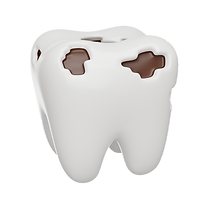
What is caries?
Tooth decay is a degenerative disease of dental hard tissues (enamel and dentin) that originates from the surface and grows deep into the tooth pulp. Caries does not give major symptoms until the advanced stage, when the tooth begins to hurt.
It is prevention that is the first treatment for caries.
Caries arises from the disruption of the balance of the bacterial flora normally present in the mouth. The bacteria in plaque use sugars from food to survive and at the same time produce acidic waste substances, which are capable of causing injury to tooth enamel. If plaque is not carefully removed, these lesions, initially reversible, can evolve to generate a cavity in the tooth.

Causes
Bacteria present in the mouth.
Sugars.
Genetic predisposition.
Dear
Fillings.
Inlays on permanent teeth.
Conscious sedation with courage mask
Treating tooth decay painlessly.
Treatment Duration:
Each session takes about 20 minutes
Prevention
Sealing.
Hygiene sessions.
The symptoms of tooth decay
Usually caries does not cause symptoms and can only be diagnosed during a checkup.
Symptoms begin to appear in the advanced stage, when caries reaches the pulp, causing structural destruction of a portion of the tooth.
Symptoms may be:
pulsating, sharp pain;
pain on chewing;
pain caused upon eating sweet, very hot or very cold foods.
Sometimes, it is possible to notice for oneself the signs of caries on the teeth, especially on the front teeth, which are more accessible and easy to see, such as: holes, brown or black spots.
The causes of caries
A number of factors must coexist for caries to develop:
presence of bacteria capable of producing acids that alter tooth structure;
availability of sugars in the diet that promote bacterial growth and adhesion;
genetic factors that erode tooth strength and promote bacterial growth;
tooth quality;
the shape of the tooth and arch;
the characteristics of saliva.

Preventing caries with sealants
Sealants
Sealing is a dental treatment that prevents caries. It is generally performed on permanent molars, the teeth most at risk because they present deep grooves and are the most difficult to clean well with a toothbrush. We use specific non-toxic resins for sealings.
Why perform a sealant?
It is a quick and painless treatment, a good ally for preventing tooth decay in the future.
How is the sealing performed?
Sealing is quick, simple and painless. It starts with a deep cleaning of the grooves of the permanent molars. Then a deep cleansing with a blue paste and, finally, varnishing with a liquid resin, the sealant.
What is the durability of the sealant?
A good sealant done properly provides protection from caries for many years, and if the sealant becomes damaged, the procedure can be repeated.
Preventing caries with fluoride treatment
If the paediatric dentist considers the child to be particularly caries-receptive or if he or she wears orthodontic braces, it is important to have him or her checked more frequently to prevent caries and to apply higher concentrations of fluoride.
In the dental office, special gels containing fluoride in concentrations 10 to 15 times higher than normal toothpastes are applied.
The frequency of applications is determined by mutual agreement between the paediatric dentist and the oral hygiene doctor, according to the needs that emerge.
Practical advice
Brush your teeth twice a day.
Drink plenty of water.
Eat fruits and vegetables.
Few sweets outside main meals.

The stages of the pathway
The Visit
During the first visit, the pedodontist searches for holes in the enamel using a sharp probe. If during the probing of the furrows the probe becomes blocked, there is confirmation of dentin softening. Technological confirmation is then made through the use of radiographs.

1
Caries prevention
Good prevention is the first step in avoiding cavities.
We recommend:
brush your teeth with a fluoride toothpaste at least twice a day, preferably after every meal;
reduce foods and drinks with sugars and starchy foods;
floss daily to remove food debris and plaque;
make regular checkups twice a year;
seal permanent molars to protect the chewing surfaces of the teeth;
regular dental hygiene sessions.

3
The treatment of caries
Dental filling is performed, restoring tooth structure, morphology and integrity. It is a painless treatment, thanks to the use of conscious sedation, which helps the child relax and cooperate with his or her pedodontist.

2
Clinical cases
Our Services
From our Blog
They say about us.
28 ott 2021
Nicole A.
Ci tornerò sicuramente!
Ambiente accogliente, pulito e team professionale, specializzato e preparato. La tecnologia del laser, che non conoscevo, è una cosa pazzesca: mi è stata curata la carie ed io non ho sentito nulla. Prezzo giusto per il servizio. Ci tornerò sicuramente!
3 ott 2023
Giuseppe E.
Tutti i medici molto preparati e disponibili
Che dire è più di 30 anni che vengo in questo centro significa che mi trovo molto bene . Tutti i medici molto preparati e disponibili
17 ott 2023
Luca P.
Struttura super organizzata
Il centro Andriolo non è un classico studio dentistico, ma una struttura super organizzata nella quale tutti lavorano per prendersi cura del paziente dalla A alla Z; e lo fanno con una passione, professionalità e programmazione fuori dal normale. Dall’accettazione al post intervento mi sono sentito sempre seguito e ascoltato!!















